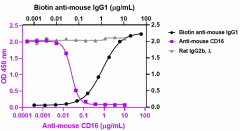- Clone
- W20015B (See other available formats)
- Regulatory Status
- RUO
- Other Names
- Fc-Gamma Receptor III-2 (CD16), Immunoglobulin G Fc Receptor III, Fc Fragment Of IgG, Low Affinity III, Receptor For, Low Affinity Immunoglobulin Gamma Receptor III-A Fc Fragment, Fc Fragment Of IgG Receptor IIIa, Fc-Gamma RIII-Alpha
- Isotype
- Rat IgG2b, λ

-

Biotin anti-mouse IgG1 (Cat. No. 406604) (black circles) binds to immobilized recombinant mouse FcγRIII (CD16) (Cat. No. 790104). Ultra-LEAF™ purified anti-mouse CD16 (clone W20015B) (purple squares) inhibits the binding in a dose-dependent manner whereas the purified rat IgG2b, λ isotype control (Cat. No. 403801) (gray triangles) does not have the effect. This antibody blocks the binding of 11 µg/mL biotin anti-mouse IgG1 to 5 µg/mL immobilized recombinant mouse FcγRIII (CD16). ND50 range: 0.02 - 0.15 µg/mL
| Cat # | Size | Price | Quantity Check Availability | ||
|---|---|---|---|---|---|
| 945803 | 100 µg | $358.00 | |||
| 945804 | 1 mg | $1205.00 | |||
Select size of product is eligible for a 40% discount! Promotion valid until December 31, 2024. Exclusions apply. To view full promotion terms and conditions or to contact your local BioLegend representative to receive a quote, visit our webpage.
CD16, also known as FcγRIII, is a low affinity IgG Fc receptor for a broad range of different isotypes. It primarily exists as two distinct forms: FcγRIIIA/CD16a and FcγRIIIB/CD16b, which are encoded by two nearly identical genes in humans. The expression of the two isoforms is tissue-specific. FcγRIIIA is a 50-65 kD type I transmembrane protein that is expressed on the surface of NK cells, activated monocytes, macrophages, and placental trophoblasts in humans. FcγRIIIB is a 48 kD GPI-anchored protein. Its extracellular domain is over 95% homologous to that of FcγRIIIA, and it is expressed specifically on neutrophils. FcγRIIIA can bind aggregated IgG or IgG-antigen complex which functions in NK cell activation, phagocytosis, and antibody-dependent cell-mediated cytotoxicity (ADCC). Several studies indicated that the post-translational modifications of FcγRIIIA or IgG regulate FcγRIIIA-mediated functions. The glycosylation of FcγRIIIA is mandatory for high affinity binding to Fc. Additionally, lack of fucosylation of Fc glycans dramatically enhance ADCC by improving the binding of FcγRIIIA and IgG. It has been reported that the polymorphism (F176V) showed a greater binding capacity to IgG, leading to increasing antibody-dependent NK cell cytotoxicity and susceptibility to autoimmune diseases. The missense mutation (L66H) causes immunodeficiency 20 disease (IMD20). FcγRIIIA associates with γ and zeta chains of T-cell antigen receptor complex (CD3:TCR) and FcεRIγ on human NK cells, suggesting involvement of distinct signal-transducing function.
Product Details
- Verified Reactivity
- Mouse
- Antibody Type
- Monoclonal
- Host Species
- Rat
- Immunogen
- Recombinant mouse CD16 (Fcγ RIII)
- Formulation
- 0.2 µm filtered in phosphate-buffered solution, pH 7.2, containing no preservative.
- Preparation
- The Ultra-LEAF™ (Low Endotoxin, Azide-Free) antibody was purified by affinity chromatography.
- Concentration
- The antibody is bottled at the concentration indicated on the vial, typically between 2 mg/mL and 3 mg/mL. Older lots may have also been bottled at 1 mg/mL. To obtain lot-specific concentration and expiration, please enter the lot number in our Certificate of Analysis online tool.
- Storage & Handling
- The antibody solution should be stored undiluted between 2°C and 8°C. This Ultra-LEAF™ solution contains no preservative; handle under aseptic conditions.
- Application
-
Block - Quality tested
- Recommended Usage
-
Each lot of this antibody is quality control tested by blocking the binding of 11 µg/mL biotin anti-mouse IgG1 antibody (Cat. No. 406604) to 5 µg/mL immobilized recombinant mouse FcγRIII (CD16) (Cat. No. 790104). ND50 range: 0.02 - 0.15 µg/mL. It is recommended that the reagent be titrated for optimal performance for each application.
- RRID
-
AB_2910506 (BioLegend Cat. No. 945803)
AB_2910506 (BioLegend Cat. No. 945804)
Antigen Details
- Structure
- Immunoglobulin family
- Distribution
-
NK cells, activated monocytes, macrophages, neutrophils, subpopulation of T cells, immature thymocytes
- Function
- Low affinity IgG Fc receptor, phagocytosis, ADCC
- Interaction
- FcγR subunit
- Ligand/Receptor
- Aggregated IgG, IgG-antigen complex
- Cell Type
- Dendritic cells, Macrophages, Monocytes, Neutrophils, NK cells
- Biology Area
- Immunology, Innate Immunity
- Molecular Family
- CD Molecules, Fc Receptors
- Antigen References
-
- Bruhns P. 2012. Blood. 119:5640-9.
- Hirano M, et al. 2007. Nat Immunol. 8:762-71.
- Takai T. 2002. Nat Rev Immunol. 2:580-92.
- Jakus Z, et al. 2008. J Immunol. 180:618-29.
- Nimmerjahn F and Ravetch JV. 2005. Science. 310:1510-2.
- Hazenbos WL, et al. 1996. Immunity. 5:181-8.
- Hazenbos WL, et al. 1998. J Immunol. 161:3026-32.
- Watanabe N, et al. 1999. Blood. 94:3855.
- Gene ID
- 14131 View all products for this Gene ID
- UniProt
- View information about CD16 on UniProt.org
Other Formats
View All CD16 Reagents Request Custom Conjugation| Description | Clone | Applications |
|---|---|---|
| Ultra-LEAF™ Purified anti-mouse CD16 | W20015B | Block |
Compare Data Across All Formats
This data display is provided for general comparisons between formats.
Your actual data may vary due to variations in samples, target cells, instruments and their settings, staining conditions, and other factors.
If you need assistance with selecting the best format contact our expert technical support team.
-
Ultra-LEAF™ Purified anti-mouse CD16

Biotin anti-mouse IgG1 (Cat. No. 406604) (black circles) bin...
